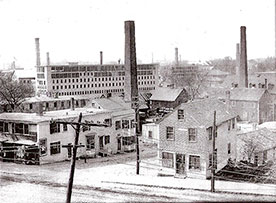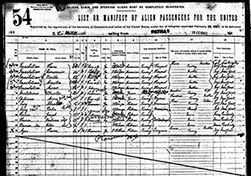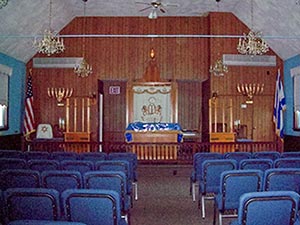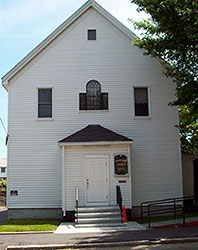Salud, Mazal, Bueno que Topas
The Sephardic Jewish Community of Peabody
Click on pictures for larger versions
In Spring 2009 I was assisting a California woman who was researching her extended family from Turkey. They had immigrated to Peabody, Massachusetts around the turn of the 20th century. Hardly anyone now is aware that there is a Jewish Sephardic Community in Peabody although they know there is a Congregation Tifereth Israel. There are four synagogues in Peabody today and to people in the area Congregation Tifereth Israel is just one of them. In fact, this one is Sephardic and was established there in 1922. Why in Peabody? Well, it was once the leather capital of the world, employing thousands of immigrants including those from Turkey and Greece.
Although Jewish families lived in Peabody as early as the 1890’s, the Sephardic Jews first settled there between 1911–1914. That influx of Turkish immigrants can probably be attributed to the uprisings in Turkey at that time. At the turn of the 20th century, Turkey was in a state of upheaval having been through several wars and a Revolution and was about to embark on another war. Like other emigrants they wanted to escape conscription or the threat of war in their home country as well as to seek a better life in the United States.
Many immigrants from Turkey were already shoe makers or leather workers so Peabody was a place where they found ample employment opportunities. In the Salem News, October 7, 1912, a lead article was “Leather Goods: The Biggest Item,” indicated that leather was a $10,000,000 business and the returns of that business resulted in the growth of other businesses such as machine shops, factory supplies, and freight service. These then resulted in the growth of more banks, telephone and mail services. The prosperity of the town was thus attributed to the leather businesses which continued to grow; the more factories, the more business.
The first Spanish Jews settled there around 1911. They lived near the leather factories on streets such as Walnut or Aborn where they could walk to work. Pictured is Main and Hawley (Grove) Streets where Joseph Havian lived showing some of the many leather factories with chimneys that emitted heavy black smokestacks polluting the city with dark smog until it was banned many decades later.
In September 1910 Leon Eskenas and Meir Benatar arrived in the US on the SS Atlantic from Constantinople, Turkey. Soon they moved to Peabody, became leather workers and sent for their wives and families. Ship manifests for 1912 show the arrival of their extended families: Morris Gibely, Robert Hasday, Nissam Eskenazi, and Joseph Havian and in 1914 the arrival of David Leon and Joseph Pernitchi. Seven of these would become the founders of the Peabody Sephardic Community, Congregation Tifereth Israel.
Although the families had lived in Constantinople, Turkey, for 500 years, they could trace their ancestors back to the Spanish Inquisition, 1492, when those who wouldn’t convert to Christianity were expelled from Spain and forced to migrate.
Some Jews openly converted but others like the Peabody congregation regarded themselves as Marranos or crypto Jews who were forced to live as Catholic in Spain but secretly carried on their Jewish traditions within their family life. The new Sephardic Jewish community of Peabody were spiritual people and sought religious services but were not comfortable with the newly formed Ashkenazi synagogue and their practices; — they didn’t fit in. They didn’t speak Yiddish or follow Ashkenazi customs and traditions. Other Jews, regardless of the Eastern European country of origin, spoke Yiddish and had a common language with each other. The Sephardics spoke Ladino, a Judeo/Spanish language, which is a combination of Hebrew and Spanish passed down through their Spanish ancestry. Ladino is written in Hebrew and used in their religious services.
Their services also varied from the Ashkenazi’s for example as explained by then Congregation President Joe Gibely in a Congregation anniversary speech, March 1979. His speech opens with “Shalom ! Salud, Mazal, Bueno que Topas” (Peace ! Health, luck and good fortune) and follows later with “It is a great honor to be called to the Sefer during the High Holidays and in most synagogues . . . only a select few are honored. In Congregation Tifereth Israel all adult males are honored by being called to the Sefer. There are two unique things that happen when a designated congregant is called. The moment his name is called all his younger relatives rise and remain standing while he recites his blessings before and after the Torah is read. This shows respect for someone older than you.”
The second thing is that all other worshipers call out “Bekhavod” or “in honor” as he goes to the Bimah. Eric Havian, a descendant of all the founders, says he was never really sure how all the congregants were related to him but remembers when he stood to read the Torah as a youth, nearly every female was required to stand (it’s because he was related to practically all other members). He remembers that “tradition was that men related to him but younger were required to stand and all females related had to stand.”
Ironically, I was initiated into my research of the Sephardic congregation during coffee with now Congregation President Elliot Hershoff, at McDonalds on Main Street, Peabody. He informed me that this location was 133 Main Street — the same place where the house once stood of early Sephardic congregation members, the Yonis family and next door to them were the Havians. He later provided a tour of the Congregation and described its Sephardic history from the time of arrival in Peabody.
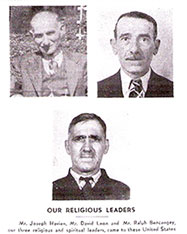
Initially the early Jewish families of Spanish faith worshiped among themselves taking turns leading the services at their homes. Soon they rented space over a garage (Sullaway’s) at 167 Boston Rd on the Salem/Peabody line and thus the seven men, Leon Eskenas, Nissam Eskenazi, Morris Gibely, Joseph Havian, David Leon and Joseph Pernitchi with Ralph Bencangey as one of their spritual leaders became the founders of the Sephardic Congregation Tifereth Israel, February 1922. Leon Eskenas would be their President from 1922–1940.
Their services even today include prayers and rituals in the Sephardic tradition. Joanne Pernitchi Pressman, also a descendant of all the founders, is now the Cantor at their current Synagogue. She explains: “For many years all services were run by lay leaders of the Congregation. Rabbi Pikelny served on a volunteer basis from Fall 1982 to May 2001, when he died quite suddenly. Initially his wife, Barbara Pikelny, who was classically trained at Juilliard and proficient in reading Hebrew, acted as our cantor. On the eve of Yom Kippur 1990, she suffered a stroke and was hospitalized. When we all arrived for Kol Nidre services and learned what had happened we continued with the service and I was asked by my uncle, Victor Havian, to sit on the Bimah and assist with the melodies and chanting. I had no formal training, other than five years of Hebrew School as a child, but I had learned many Sephardic melodies from my mother, aunts and uncles. I had some additional lessons from Barbara Pikelny before her health worsened, and she was able to prepare my mother and me to become Bat Mitzvah at a joint service, May 1991. At that time my mom had just turned 70 years old and I was 43. I have been a soloist for Congregation Tifereth Israel ever since.”
In addition to the synagogue, the Congregation has a separate cemetery section within Sons of Jacob Cemetery, Danvers, MA. The Tifereth Israel area is on the lower level where the earliest graves are from 1921–1930 and are scripted in Ladino. Other Sephardic gravestones are on the upper level such as Israel Benatar d. 1919. His stone overlooks the others and has a lengthy Ladino inscription as illustrated. When translated it tells the name of his father and wife and that he had three children and how much he’ll be missed. Other stones are yet to be translated because there are few locals who can read or translate this language. The Hebrew words on the gravestones transliterate into Ladino which is similar to Spanish but also has its own vocabulary. The grave of Leon Hasday was already very loosely transliterated and reads:
“Leon Hasday, died at the age of 21, Dearly beloved son, Transform? soon to your final resting place. It causes complete sorrow that your life is ended. I pray to God Almighty that your spirit is at rest and that your [ ] is peaceful. 5 June 1928”
Although the early families left Turkey to avoid conscription, their descendants fought nobly in the world wars of the United States. On Memorial Day the Veterans’ Association places dozens of flags at the Veterans’ gravesites in this small Sephardic cemetery. Congregation member Ralph Yonis gave his life for this country and is honored on a WW II memorial at Peabody City Hall.
Today the congregation is still at Pierpont Street, Peabody a building purchased from the Church of the Nazarene in 1955. It now has a paid, part-time Rabbi, Howard Kosovske, and much of the service is Ashkenazi, as are about half the membership. However, Sephardic traditions still exist within the service. On the High Holidays they will again continue the Sephardic ritual of auctioning the Mitzvoths prior to the removal of the Torah from the Ark. That ceremony is in Ladino and, according to Joe Gibely’s speech, includes seven mitzvoths starting as such: “1. Quanto dun por la Petihai (what is offered to open the doors of the ark) 2. Quanto dun por el sefer reeshon? (what is offered to carry the first sefer torah 3. Quandto dun” and so forth . . . as their tradition continues.
Copyright © 2009 by Marjorie J. Short and used with permission of Mass Pocha, Jewish Genealogical Society of Greater Boston, MA. Marjorie is a retired Professor of Middlesex Community College; member of JGSGB, Beverly (MA) Historical Society, Jewish Historical Society of the North Shore, Millis (MA) Historical Society; JCAM, and a genealogical assistant to many.

